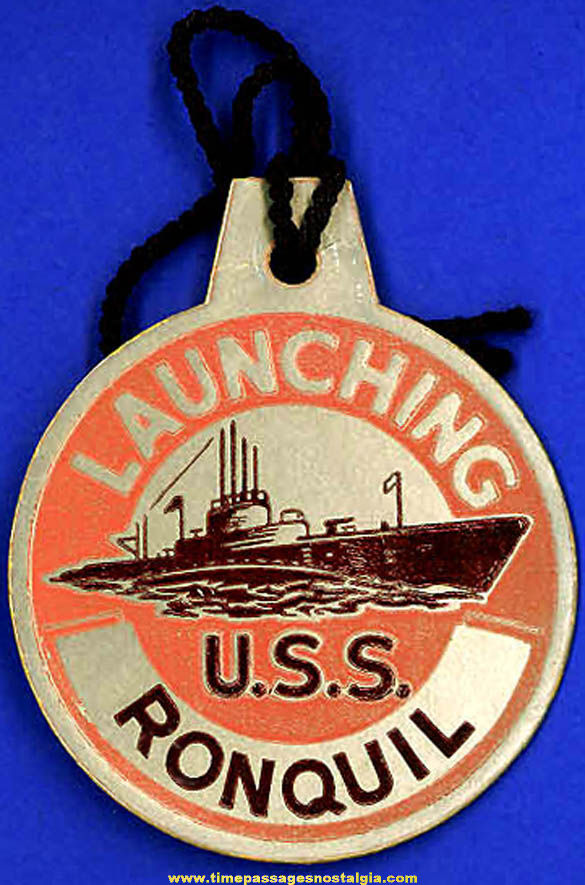
 | Item #k911 | 
Price: $19.99
$6 shipping & handling
For Sale
|
|
  | | Any group of items being offered as a lot must be sold as a lot. | | | All Original Items.
No Reproductions | Don't forget to
bookmark this site. | Nostalgic Memorabilia, Pop Culture Artifacts, Historic Items,
and "Shoe Box Toys" | You don't have to be an eight year old to enjoy having
a childhood treasure. | | Worldwide Sales | Quality Packing And
Postal Insurance | | We have an extensive inventory that is not yet on our web site. If there is something you are looking for and did not find, please send us your wish list. | Whether you've collected Memorabilia for years or just want to feel like a kid again, please take a few moments to browse through what we
have available for sale. |
| | | | The picture below shows a larger view of this 1944 U.S.S. Ronquil SS-396 Submarine Launching Souvenir Tag. This launching badge is believed to have been saved by a Portsmouth Naval Shipyard worker. It was found in New Hampshire with many others dating from 1943 to 1944 when many ships and submarines were built and launched to do battle in World War II. They had been hidden away since the 1940s until 2015. The submarine was launched from The Portsmouth Naval Ship Yard in Kittery, Maine. This cardboard tag has its original black cord attached. It is imprinted in black and pink on a silver background. The back side is identical. It pictures a United States Navy Submarine and it is marked as follows: LAUNCHING
U.S.S. RONQUIL The tag measures 1-3/4'' wide. It appears to be in mint condition as pictured. Below here, for reference, is some historical information on the U.S.S. Ronquil SS-396 submarine: U.S.S. Ronquil (SS-396)
From Wikipedia, the free encyclopedia History
United States
Name: U.S.S. Ronquil (SS-396)
Builder: Portsmouth Naval Shipyard, Kittery, Maine
Laid down: 9 September 1943
Launched: 27 January 1944
Commissioned: 22 April 1944
Decommissioned: May 1952
Recommissioned: 16 January 1953
Decommissioned: 1 July 1971
Struck: 1 July 1971
Fate: Transferred to Spain, 1 July 1971 Spain
Name: SPS Isaac Peral (S-32)
Acquired: 1 July 1971
Decommissioned: 3 April 1984 General characteristics
Class & type: Balao class diesel electric submarine
Displacement: 1,526 tons (1,550 t) surfaced, 2,391 tons (2,429 t) submerged
Length: 311 feet 6 inches (94.95 m)
Beam: 27 feet 3 inches (8.31 m)
Draft: 16 feet 10 inches (5.13 m) maximum
Propulsion: 4 - Fairbanks Morse Model 38D8 10 cylinder opposed piston diesel engines driving electrical generators, 2 - 126 cell Sargo batteries, 4 - high speed Elliott electric motors with reduction gears, two propellers, 5,400 shp (4.0 MW) surfaced, 2,740 shp (2.0 MW) submerged
Speed: 20.25 knots (38 km/h) surfaced, 8.75 knots (16 km/h) submerged
Range: 11,000 nautical miles (20,000 km) surfaced at 10 knots (19 km/h)
Endurance: 48 hours at 2 knots (3.7 km/h) submerged, 75 days on patrol
Test depth: 400 feet (120 m)
Complement: 10 officers, 70 - 71 enlisted
Armament: 10 - 21 inch (533 mm) torpedo tubes, 6 forward, 4 aft, 24 torpedoes, 1 - 5 inch (127 mm) / 25 caliber deck gun, Bofors 40 mm and Oerlikon 20 mm cannon General characteristics (Guppy IIA)
Class & type: none
Displacement: 1,848 tons (1,878 t) surfaced, 2,440 tons (2,479 t) submerged
Length: 307 feet (93.6em)
Beam: 27 feet 4 inches (8.3 m)
Draft: 17 feet (5.2 m)
Propulsion: Snorkel added, One diesel engine and generator removed, Batteries upgraded to Sargo II
Speed: Surfaced: 17.0 knots (19.6 mph; 31.5 km/h) maximum, 13.5 knots (15.5 mph; 25.0 km/h) cruising, Submerged: 14.1 knots (16.2 mph; 26.1 km/h), 8.0 knots (9.2 mph; 14.8 km/h) snorkeling, 3.0 knots (3.5 mph; 5.6 km/h) cruising
Armament: 10 - 21 inch (533 mm) torpedo tubes, (six forward, four aft), all guns removed The U.S.S. Ronquil (SS-396), a Balao class submarine, was the only ship of the United States Navy named after the ronquil, a spiny finned fish found along the northwest coast of North America. It has a single dorsal fin and a large mouth and resembles the tropical jawfish.
Ronquil was laid down 9 September 1943 at the Portsmouth Navy Yard, in Kittery, Maine; launched 27 January 1944, sponsored by Mrs. C. M. Elder; and commissioned 22 April 1944, Lieutenant Commander Henry S. Monroe in command.World War II
After shakedown off the New England coast, Ronquil sailed for Hawaii. She arrived at Pearl Harbor on 8 July 1944; and, after preparatory training, sailed on her first war patrol (31 July - 8 September 1944) in the northeastern Formosa Sakishima Gunto area. On 24 August the submarine sank two attack cargo ships: Yoshida Maru No. 3 (4,646 tons) and Fukurei Maru (5,969 tons). Ronquil’s second war patrol, from 30 September to 28 November 1944, was carried out in two phases. She first operated with a coordinated submarine attack group in the Bungo Suido area, and then joined six other submarines to carry out an antipatrol ship sweep off the Bonin Islands. On her third war patrol, from 1 January to 14 February 1945, Ronquil patrolled the Bonins and did lifeguard duty in that area for Army bombers hitting the Japanese home islands. Her fourth war patrol from 11 March to 23 April 1945, brought her no worthwhile enemy targets but resulted in the rescue of 10 Army aviators from a B-29 bomber downed between the Bonins and Japan. The submarine's fifth and last patrol from 19 May to 26 July 1945, took her into the East China Sea and the Yellow Sea. The end of the war in the Pacific found Ronquil off Pearl Harbor, training for another war patrol. She returned to San Diego in the fall of 1945 and engaged in training exercises off the California coast. Post war service
In January 1947, Ronquil departed San Diego for her first peacetime western Pacific deployment. This patrol lasted 114 days and took the submarine to Tahiti, the Carolines, the Marianas, Japan, and the Yellow Sea. On her return to San Diego, she resumed local operations before beginning a 3 year period of intensive training in offensive and antisubmarine warfare, embodying lessons learned during World War II as well as new postwar developments. Ronquil entered Mare Island Naval Shipyard in May 1952 for decommissioning and ''Guppy IIA'' modernization: Her hull and sail were streamlined for greater submerged speed. She received new, increased capacity batteries for underwater endurance, and a snorkel which enabled her to use her diesels at periscope depth. New electronics, including improved sonar and fire control systems, were installed. Ronquil was recommissioned on 16 January 1953, and on 12 June departed for Japan. She arrived at Yokosuka before sailing on to Tokyo on 19 July to take part in the ''Black Ship Festival'' commemorating Commodore Matthew Perry's opening of Japan in 1852. Throughout August and September, Ronquil participated in antisubmarine and other operations in the waters near Japan; this was to set the pattern for most of her later deployments. On 11 December 1953 Ronquil returned to San Diego for a year of overhaul, refresher training, Naval Reserve training, and fleet exercises. She sailed for a second western Pacific tour on 21 March 1955, returning late in September. The next 2 years were devoted to operations off the west coast of the United States; on 31 July 1957, the submarine again deployed to the Far East for 7 months. From 3 July to 7 July 1958, Ronquil took part, with other ships of the fleet, in an observance of the 50th anniversary of the arrival of the ''Great White Fleet'' at San Francisco. She resumed normal operations, then sailed from San Diego on 6 April 1959 for a 5-month ''WestPac'' deployment. During July and August 1960, she participated in extensive antisubmarine exercises in the eastern Pacific with United States and Canadian forces. In the early fall of 1961 Ronquil again sailed for the Far East, returning in March 1962. After taking part in a demonstration of antisubmarine operations for the national radio and television networks, she began a period of overhaul and local operations. The submarine departed San Diego in November 1963 for duty with the 7th Fleet; on her return to California, she again resumed operations off the west coast. Late in 1964 Ronquil began preparations for deployment to the Vietnam area. In February 1965 she sailed for Southeast Asia and a five month deployment. In mid 1966, Ronquil rejoined the 7th Fleet, returning to San Diego in February 1967 for further work off the coast of California. This was interrupted in August, when Ronquil played the part of the fictional USS Tigerfish (SSN-509) in the motion picture Ice Station Zebra. On 26 December the submarine was again underway for Japan. During this deployment, she took part in exercises with United States, British, Japanese, Australian, and Canadian forces. On 2 July 1968 Ronquil returned to the west coast. Ronquil departed for the Far East 4 July 1969, returning to San Diego on Christmas Eve.
At the end of January 1970 Ronquil began a period of repair and overhaul, followed by training and fleet exercises in the eastern Pacific. August 1970 brought another 7th Fleet deployment, returning to her homeport of San Diego on 5 March 1971. The Vietnam Service Medal was awarded for this deployment.SPS Isaac Peral (S-32)
On 1 July 1971, Ronquil was decommissioned, struck from the Naval Register, and transferred to Spain, under the Mutual Security Assistance Act. The submarine was commissioned into the Spanish Navy as Isaac Peral (S-32), named after Spanish submarine pioneer Isaac Peral. Under her new commander Lt. Cmdr. Pedro Soler Yolif, she sailed from San Diego to her new homeport of Cartagena, Spain, arriving 22 August. Isaac Peral faced retirement in 1982, but her service was extended until the commissioning of the new Siroco. The Spanish Navy decommissioned Isaac Peral on 3 April 1984. Honors and awards
Ronquil earned six battle stars for World War II service. |
|
Click on image to zoom.
 |